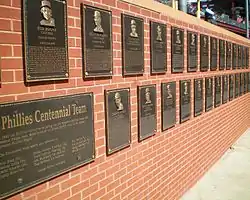Jack Coombs
John Wesley Coombs (November 18, 1882 – April 15, 1957), nicknamed "Colby Jack" after his alma mater, was an American professional baseball player. He played in Major League Baseball as a pitcher for the Philadelphia Athletics (1906–14), Brooklyn Robins (1915–18), and Detroit Tigers (1920). A two-way player, Coombs also occasionally played the outfield. Coombs set a number of American League and World League records which still stand and, when he won 31 games while losing nine in 1910, he became one of only 13 pitchers to win 30 games in a season since 1900.
| Jack Coombs | |||
|---|---|---|---|
 Jack Coombs, circa 1911 | |||
| Pitcher, Outfielder | |||
| Born: November 18, 1882 LeGrand, Iowa | |||
| Died: April 15, 1957 (aged 74) Palestine, Texas | |||
| |||
| MLB debut | |||
| July 5, 1906, for the Philadelphia Athletics | |||
| Last MLB appearance | |||
| July 18, 1920, for the Detroit Tigers | |||
| MLB statistics | |||
| Win–loss record | 158–110 | ||
| Earned run average | 2.78 | ||
| Strikeouts | 1,052 | ||
| Teams | |||
| |||
| Career highlights and awards | |||
| |||
Early life
Born in LeGrand, Iowa, Coombs moved to Kennebunk, Maine with his family at the age of four. He played baseball in high school in Freeport, Maine, and, in 1901–2, for Coburn Classical prep school in Waterville.[1][2] Coombs was a 1906 graduate of Colby College in Waterville, where he was a chemistry major and a member of Delta Upsilon. He also participated in football, track, and tennis. Colby's baseball field is named for him.
Baseball career
_(1911)_(14801801473).jpg.webp)
Three weeks after graduating, Coombs pitched in his first major league game for Philadelphia, a seven-hit shutout, defeating the Washington Senators 3-0. He finished 1906 with a 10-10 record and 2.50 ERA. In 1906, he pitched the longest complete game in the American League, 24 innings against Boston, winning 4-1.[1] The following year, Coombs went 6-9 with a 3.12 ERA. In 1908 and 1909, his record was only 19-16 despite his ERA being 2.00 and 2.32 those years.
Coombs' best season was 1910, which is still one of the best single pitching seasons in MLB history. Besides his record of 31–9, he led the American League in wins (31), games played (45), and shutouts (13), which is still the single season AL record. He won 18 of 19 starts that July and racked up 53 consecutive scoreless innings, which stood as the major league record until Walter Johnson broke it three years later. Don Drysdale and Orel Hershiser have since surpassed Johnson's mark.

Coombs also won three games in the 1910 World Series, in which the Athletics defeated the Chicago Cubs.
He made appearances in the 1911 and 1916 World Series. In 1919, Coombs was the manager of the Philadelphia Phillies for 62 games, going 18-44 before being replaced by Gavvy Cravath. He returned to play one final year in 1920 before retiring.
Coombs was an adept hitting pitcher in his 14-year major league career, compiling a .235 batting average (261-for-1110) with 123 runs, 4 home runs and 100 RBI. He played more than 60 games in the outfield during his career. In six World Series games, he hit .333 (8-for-24) with 4 RBI.
Films
- World's Championship Series (1910) *docu. short
- The Baseball Bug (1911) *short
- Animated Weekly, No. 41 (1916) *docu. short
- World Series Games 1916, Boston vs. Brooklyn (1916) *documentary
- The Baseball Revue of 1917 (1917) *documentary
Later life
Coombs became a championship-winning coach at Duke University (1929–52) who sent many players to the majors. Duke University's baseball field is named after him.
He spent his retirement as a sports historian and writer. In 1938, he published, Baseball – Individual Play and Team Strategy.
See also
References
- Jack Coombs. Article written by C. Paul Rogers III. SABR Biography Project.. Retrieved on July 23, 2019.
- The National Pastime. Freeport Historical Society. Retrieved on July 23, 2019.
- "The Baseball Bug". Thanhouser Company Film Preservation, Inc. Archived from the original on 2017-01-07. Retrieved 2016-01-22.
External links
- Career statistics and player information from Baseball-Reference, or Baseball-Reference (Minors), or BR Bullpen, or Cuban-American Major League Clubs Series, or Retrosheet, or SABR Biography Project, The Baseball Cube, or The DeadBall Era
